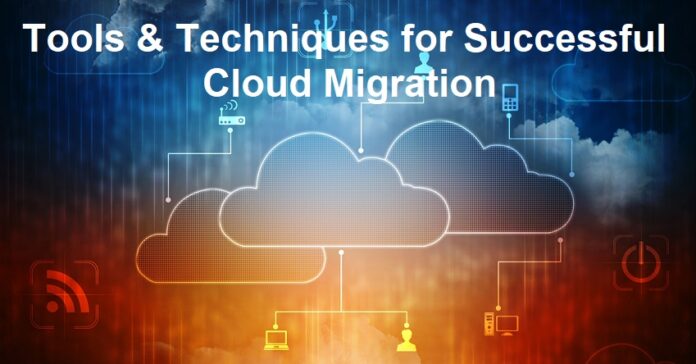
In the fast-paced digital world, businesses are constantly evolving to adapt and stay ahead. One of the most transformative technological shifts we’ve seen in recent years is transitioning from traditional data storage systems to the cloud. This process is known as cloud migration.
Cloud migration is moving data, applications, and other business elements from an on-premises data center to a cloud-based infrastructure. It can also refer to moving from one cloud environment or platform to another. This shift offers a multitude of benefits, including cost savings, enhanced data security, scalability, and operational efficiency.
The transition to cloud computing has revolutionized how businesses operate, making them more agile, responsive, and resilient. Organizations of all sizes, from startups to large corporations, are increasingly migrating to the cloud to leverage these advantages and stay competitive in today’s market.
However, migrating to the cloud is a complex switch. It’s a strategic move that requires careful planning and execution. Successful cloud migration is much more than a mere technology change. It involves completely transforming business operations, influencing how businesses manage resources, handle data, and interact with customers. And it’s here that cloud computing courses play a pivotal role.
Importance of Adequate Planning in Cloud Migration
Embarking on a cloud migration journey without a solid plan is akin to setting sail on a tumultuous sea without a compass. Inadequate planning can result in unexpected costs, data loss, downtime, and several other complications. That’s why it’s essential to map out a detailed and robust cloud migration plan before starting your journey.
A well-structured plan serves as your guiding light during the entire cloud migration process, ensuring you’re on the right track and helping you anticipate and address potential challenges. It lays the foundation for a smooth transition, minimizing disruptions and maximizing benefits.
Critical elements of an exemplary cloud migration plan include:
- Understanding Business Objectives: Identifying the reasons behind the migration and defining what success looks like is crucial. It could be cost reduction, increased agility, improved data security, or any other business goal that drives the direction of your migration plan.
- Assessing Current Infrastructure: Conduct a thorough audit of your existing IT infrastructure. Identify the data, applications, and workloads that will be migrated, and consider their compatibility with the proposed cloud environment.
- Choosing the Right Cloud Environment: Public, private, or hybrid? The cloud model choice depends on your business needs, budget, and data sensitivity.
- Security and Compliance Planning: Ensure your plan addresses security measures, regulatory compliance, and data privacy standards.
- Resource Allocation: Consider the resources you need for migration – regarding technology and personnel. You may need to train your team or recruit cloud professionals.
The Cloud Migration Process
The process of cloud migration can seem complex and daunting. However, when broken down into manageable stages, it becomes a structured journey that any organization can navigate with the proper guidance.
Let’s delve into the four main phases of the cloud migration process:
- Assessment: This initial stage involves a comprehensive analysis of your current IT environment, which includes understanding the intricacies of data, applications, workloads, and infrastructure. The primary objective is identifying what needs to be migrated and how it will interact with the cloud environment. The assessment stage also includes understanding the cost of running your current infrastructure versus anticipated cloud costs.
- Planning: As previously emphasized, robust planning is integral to successful cloud migration. This phase includes defining your cloud strategy, identifying the appropriate cloud model, designing a detailed migration plan, and preparing a contingency plan.
- Migration: The migration phase is where your plans are put into action. Data and applications are moved from the on-premises infrastructure to the cloud. Minimizing disruptions to your operations during this phase is crucial, which requires diligent monitoring and management. You can adopt different migration strategies, such as rehosting (lift-and-shift), replatforming, repurchasing, refactoring, retiring, or retaining, each with its own benefits and challenges.
- Post-migration: Once the migration is completed, the work doesn’t stop. It’s essential to validate the success of the migration and ensure everything is working as expected. This phase falls under regular monitoring, performance optimization, cost management, and ensuring security and compliance.
Each phase of the cloud migration process presents its unique challenges and requires different skills and expertise. That’s where cloud computing courses come into play. A well-rounded program will cover all aspects of the migration process, providing you with the knowledge and tools to tackle any hurdles you may encounter during your cloud migration journey.
Strategies for Successful Cloud Migration
Just as there’s no one-size-fits-all solution in business, cloud migration also requires a tailored approach. Your chosen strategy largely depends on your business needs, resources, and objectives.
Here, we’ll explore some common cloud migration strategies and provide tips on how to choose the one that best suits your organization:
- Rehosting (Lift-and-Shift): This strategy involves moving applications and data from your existing environment to the cloud without making changes. It’s often the quickest and least expensive strategy, but it may not fully leverage the cloud’s capabilities.
- Replatforming: Replatforming means making a few cloud-optimized adjustments to your applications during the migration process, offering a good balance between cost, speed, and leveraging cloud benefits.
- Refactoring (Re-Architecting): Refactoring involves re-architecting your applications to take full advantage of the cloud’s capabilities. It’s the most time-consuming and costly strategy, but it can yield significant long-term benefits, especially for businesses looking to boost agility and speed.
- Repurchasing: This strategy involves moving from a traditional license to a cloud-based model. For instance, transitioning from a conventional customer relationship management (CRM) system to a cloud-based one like Salesforce.
- Retiring: After an assessment, you might find some of your applications are no longer needed. In such cases, you can eliminate them to save costs.
- Retaining: Some applications may need more time to be ready or suitable for cloud migration. It’s okay to retain these applications in your current environment until later.
Tools and Techniques for Successful Cloud Migration
Just as a carpenter needs a well-stocked toolbox to create quality work, businesses also need the right tools and techniques for successful cloud migration. Using the appropriate tools can streamline the process, reduce errors, and save valuable time and resources.
Here, we’ll discuss some essential tools and techniques that can help ensure a smooth cloud migration process:
- Migration Assessment Tools: Before beginning your cloud migration journey, it’s crucial to understand your current IT landscape. Tools like Microsoft’s Azure Migrate or AWS’s Migration Evaluator can assess your existing infrastructure, giving you valuable insights to plan your migration effectively.
- Cloud Management Platforms: They allow you to manage cloud services and resources effectively. These platforms provide features for orchestration, automation, and the provisioning and de-provisioning of resources. Examples include IBM Multi-Cloud Manager and BMC Cloud Lifecycle Management.
- Containerization: Containerization is a technique that packages an application along with its dependencies, making it easily portable across different computing environments. Tools like Docker and Kubernetes facilitate this process and enhance the efficiency of cloud migration.
- Migration Services: Cloud providers offer various services to aid the migration process. For example, AWS Server Migration Service (SMS) or Azure Site Recovery simplifies migrating existing applications to the cloud.
- Data Transfer Tools: Large amounts of data must be transferred during cloud migration. Tools like AWS Snowball and Google’s Transfer Appliance provide secure and efficient data transfer.
- Security Tools: Securing your data and applications in the cloud is paramount. Cloud-native security tools such as Azure Security Center or Amazon Inspector can help ensure your cloud environment is secure and compliant.
- Monitoring and Performance Tools: Monitoring tools are essential to track the performance of your applications in the cloud. Tools like New Relic and Datadog can provide real-time insights into application performance.
Mastering these tools and techniques requires a strong foundation in cloud computing, and this is where a comprehensive cloud computing course can be instrumental. It offers in-depth knowledge and hands-on experience with these tools, equipping you with the skills needed for successful cloud migration.
Case Study of Successful Cloud Migration – GE Oil & Gas
To better understand the process and impact of successful cloud migration, let’s look at a real-world example – the cloud migration journey of GE Oil & Gas.
GE Oil & Gas, a subsidiary of General Electric (GE), provides equipment and services for all oil and gas industry segments. The company faced challenges in terms of scalability and performance with its traditional on-premises infrastructure. Moreover, the company was spending a significant amount of time on system maintenance, which was detracting from innovation and customer service.
The company decided to move its applications to the AWS cloud to address these challenges. They underwent a thorough planning phase, during which they identified vital applications for migration and decided to adopt a phased approach. In parallel, they provided their team with cloud computing training to upgrade their skills and prepare for migration.
The first applications they migrated were non-critical systems, which allowed the team to learn and adjust their approach without impacting crucial operations. They used AWS Database Migration Service to migrate their databases, which reduced the time and effort involved in manual migration. They also used various AWS tools to ensure the security of their data during and after the migration.
The result was a resounding success. By migrating to the cloud, GE Oil & Gas reduced its total cost of ownership (TCO) by 52%. The migration improved system reliability and performance, enabling them to focus more on innovation and customer service. Additionally, using cloud computing tools allowed them to automate several processes, reducing manual work and boosting efficiency.
This case study underlines the importance of careful planning, skill upgrading, and using the right tools in successful cloud migration. It also showcases the significant benefits of effective cloud migration – from cost savings and improved performance to increased focus on innovation.
Conclusion: The Future is in the Cloud
The journey through cloud migration is one of transformation and innovation. As we’ve explored in this post, the benefits of migrating to the cloud are substantial, but the process requires careful planning, the right strategies, and the proper tools to ensure success.
The landscape of cloud computing is rapidly evolving, making it even more critical for businesses to stay updated with the latest trends and developments. As we continue to move towards an increasingly digital world, the cloud’s role will only become more prominent.
In conclusion, the future is undoubtedly in the cloud, whether you’re a small startup or a large corporation. Businesses can unlock a new world of possibilities by successfully migrating to the cloud and fully leveraging its potential.
Author Bio
Kanchanapally Swapnil Raju is a Technical Content Strategist at Great Learning who plans and constantly writes on cutting-edge technologies like Data Science, Artificial Intelligence, Software Engineering, and Cloud Computing. He has in-hand skills in MEAN Stack development and programming languages such as C, C++, and Java. He is a perpetual learner and has a hunger to explore new technologies, enhance writing skills, and guide others.


















